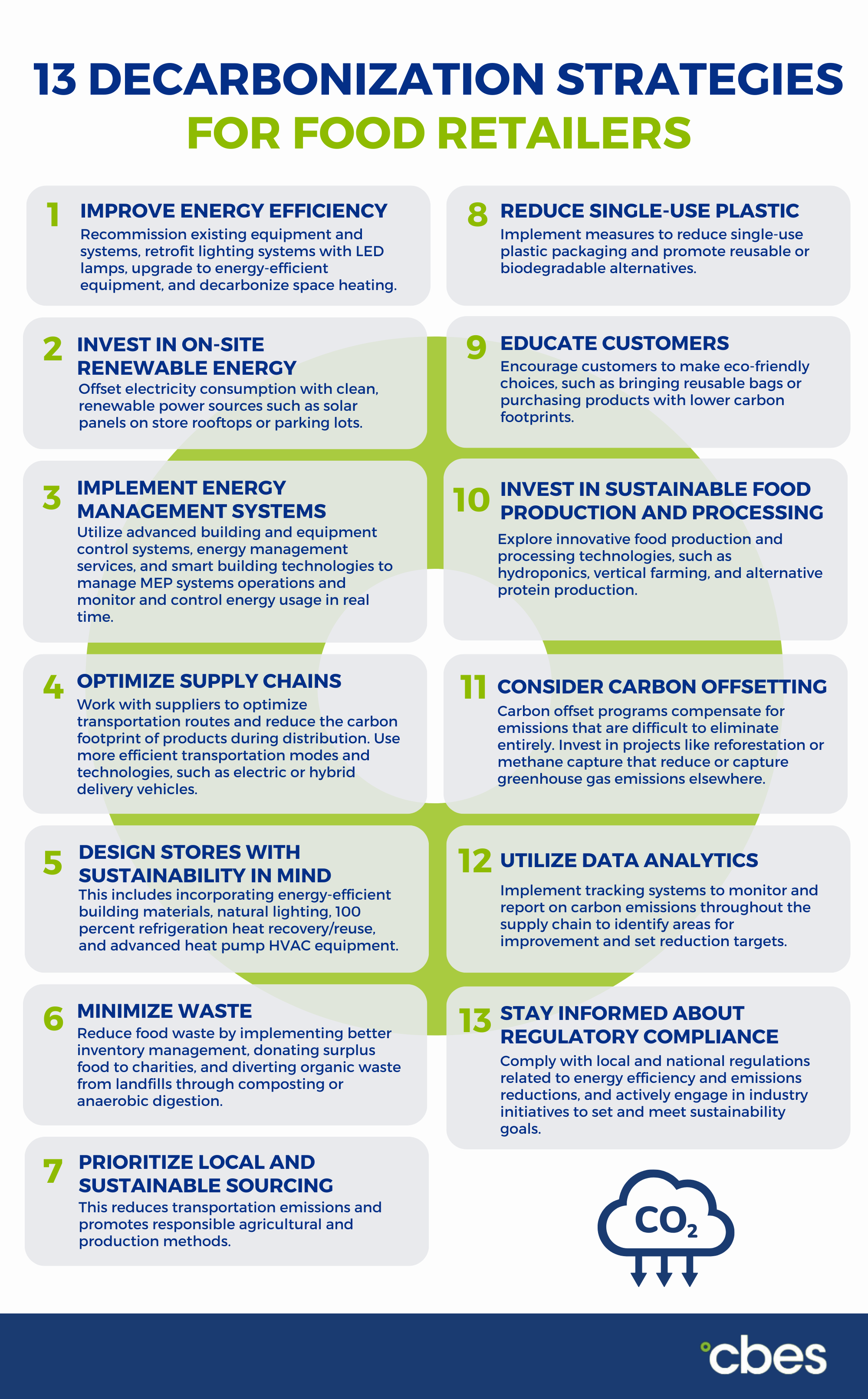
In the global effort to mitigate climate change and lower carbon emissions, the spotlight is now firmly on industries that have a significant environmental footprint. The food retail industry in particular — especially with consumers increasingly demanding eco-conscious products and practices — is well-poised to undergo a transformative shift toward sustainability in the coming years.
A greener future starts with a robust decarbonization strategy. Keep reading to learn some of the leading approaches — from innovative energy solutions to sustainable practices — that can help food retail as well as other commercial sectors develop decarbonization strategies that will not only reduce carbon footprints but also unlock new opportunities for growth and competitiveness.
Decarbonization Definition
Decarbonization is the process of reducing or eliminating carbon dioxide (CO2) emissions from various sources, primarily from the burning of fossil fuels such as coal, oil, and natural gas. The goal of decarbonization is to reduce the concentration of greenhouse gasses in the atmosphere, particularly CO2, a major contributor to global warming, and thereby mitigate climate change.
According to McKinsey, the food system is responsible for over 30 percent of global greenhouse gas emissions, and while the grocery sector’s direct contribution is relatively low, grocers have a unique chance to lead the decarbonization of the entire food system. This endeavor not only aligns with sustainability goals but also offers cost-saving benefits through energy-efficient practices and provides opportunities for differentiation and added value in their offerings to an increasingly sustainability-minded consumer base.
What Are the 8 Pillars of Decarbonization?
Decarbonization requires a comprehensive approach that encompasses not only shifts in energy sources and consumption but also fundamental changes in industry practices, transportation systems, and societal behaviors. These changes fall into eight key pillars, which together form a comprehensive framework for achieving carbon reduction goals.
- Transition to Renewable Energy: A significant part of decarbonization involves shifting from fossil fuel–based energy sources to renewable and low-carbon alternatives such as wind, solar, hydropower, and geothermal energy. These sources produce little to no CO2 emissions during energy generation.
- Energy Efficiency: Improving energy efficiency in industries, transportation, and buildings is another crucial element of decarbonization. This reduces the amount of energy required and, consequently, the associated CO2 emissions.
- Electrification: Decarbonization often involves electrifying various sectors, such as transportation and heating, where fossil fuels are traditionally used. Of course, the electricity used in these sectors should come from renewable sources to achieve a substantial reduction in carbon emissions.
- Carbon Capture and Storage (CCS): Some industries, like heavy industry and certain types of power generation, may still produce emissions even after significant efforts to reduce them. CCS technologies capture CO2 emissions from these sources and store them underground to prevent their release into the atmosphere.
- Sustainable Agriculture and Land Use: Decarbonization efforts may also involve sustainable land use practices, reforestation, and carbon sequestration in soil and vegetation to offset emissions from agriculture and land use changes.
- Transportation Shifts: Promoting public transportation, electrifying vehicles, and transitioning to alternative fuels like hydrogen can help reduce emissions from the transportation sector.
- Policy and Regulation: Government policies, regulations, and incentives play a crucial role in driving decarbonization efforts. These can include carbon pricing mechanisms, renewable energy targets, emission reduction goals, and subsidies for clean technologies.
- Technological Innovation: Ongoing research and development efforts are essential for developing new technologies and processes that reduce emissions across various sectors.
The Importance of Decarbonization in Food Retail
Why should food retailers (and other businesses) adopt decarbonization strategies? Decarbonization benefits both the planet and the bottom line in the following ways:
- Climate Impact: The grocery retail market, like many other industries, contributes to greenhouse gas emissions through their day-to-day business operations, including transportation of goods, energy use in stores, and the generation of waste. By adopting decarbonization strategies, food retailers can reduce their carbon footprint, mitigating climate change and its associated impacts, including extreme weather events that can and do cause disruptions in food supply chains.
- Customer Expectations: Consumers are increasingly concerned about the environmental impact of their purchase decisions and the businesses they support. A recent study revealed sustainability is rated as an important purchase criteria for 60 percent of global consumers and 61 percent in the U.S. Food retailers that demonstrate a commitment to sustainability and decarbonization are more likely to attract environmentally conscious customers and build brand loyalty.
- Regulatory Compliance: Governments and regulatory bodies are quickly ramping up policies to reduce emissions and combat climate change. For example, California’s roadmap to carbon neutrality by 2045 seeks to reduce greenhouse gas emissions by 85% — legislation which other states will surely closely examine and potentially use as a model for their own climate action plans. Food retailers that proactively adopt decarbonization strategies can position themselves to comply with current and future regulations, avoiding potential penalties and risks associated with non-compliance.
- Operational Efficiency: Many decarbonization strategies, such as energy efficiency improvements and waste reduction efforts, can lead to cost savings and increased operational efficiency, contributing to higher profitability. With an integrated facilities management solution such as the ones applied by City and other FM companies, retailers can expect that by the time they reduce their facility GHG emissions by 50 percent, they will have also reduced their energy-related operating expenses by 20 percent.
- Risk Management: Climate change poses risks to food retailers, including supply chain disruptions, increased food prices, and reputational damage from environmental controversies. Decarbonization efforts can help mitigate these risks by reducing exposure to climate-related challenges.
In short, in the face of evolving consumer preferences and the growing awareness of climate change, businesses that address their carbon footprint are taking a proactive role in ensuring long-term viability and sustainability.
13 Decarbonization Strategies for Food Retail
With the above pillars in mind, what can grocers do to decarbonize their operations?
As with other commercial sectors, a decarbonization strategy in the food retail market aims to reduce emissions associated with all the various aspects of business operations. Here are some of the most important decarbonization strategies:
- Energy Efficiency: Improve the energy efficiency of stores by recommissioning existing equipment and systems, retrofitting lighting systems with LED lamps, upgrading to energy-efficient equipment of all kinds, from refrigeration systems to produce wrapping machines to electronic displays, and decarbonizing space heating. The result is reduced electricity consumption and associated emissions. For more tips, check out Food Retail Energy Efficiency Best Practices for 2023.
- Renewable Energy: Invest in on-site renewable energy generation, such as solar panels on store rooftops or parking lots, to offset electricity consumption with clean, renewable power sources.
- Energy Management: Implement advanced building and equipment control systems, energy management services, and smart building technologies to manage MEP systems operations and monitor and control energy usage in real-time. These systems can optimize lighting, heating, cooling, and refrigeration systems to reduce waste and emissions.
- Supply Chain Optimization: Work with suppliers to optimize transportation routes and reduce the carbon footprint of products during distribution. Use more efficient transportation modes and technologies, such as electric or hybrid delivery vehicles.
- Store Design: Build or renovate stores with sustainability in mind. This includes incorporating energy-efficient building materials, natural lighting, full condensing 100 percent refrigeration heat recovery/reuse, and advanced heat pump HVAC equipment. Green building certifications like LEED can guide sustainable store design. To learn more, read Sustainable Grocery Store Design: 4 Common Mistakes.
- Waste Reduction: Minimize food waste by implementing better inventory management, donating surplus food to charities, and diverting organic waste from landfills through composting or anaerobic digestion.
- Local and Sustainable Sourcing: Prioritize sourcing products locally and from suppliers with sustainable practices. This reduces transportation emissions and promotes responsible agricultural and production methods.
- Reducing Single-Use Plastics: Implement measures to reduce single-use plastic packaging and promote reusable or biodegradable alternatives.
- Customer Engagement: Educate customers about sustainable choices through signage, labels, and promotional campaigns. Encourage shoppers to make eco-friendly choices, such as bringing reusable bags or purchasing products with lower carbon footprints.
- Food Production and Processing: Invest in innovative and sustainable food production and processing technologies, such as hydroponics, vertical farming, and alternative protein production, to reduce the carbon intensity of certain products like vegetables, leafy greens, and meat substitutes.
- Carbon Offsetting: Consider carbon offset programs to compensate for emissions that are difficult to eliminate entirely. Invest in projects like reforestation or methane capture that reduce or capture greenhouse gas emissions elsewhere.
- Data Analytics: Utilize data analytics and tracking systems to monitor and report on carbon emissions throughout the supply chain. This helps identify areas for improvement and set reduction targets.
- Regulatory Compliance: Stay informed about and comply with local and national regulations related to energy efficiency and emissions reductions, and actively engage in industry initiatives to set and meet sustainability goals.

Decarbonization Solutions for the Future of Retail
Decarbonization in the food retail market is a multifaceted effort that involves a number of strategies, some of which can be adopted at relatively low costs with major cost savings potential. Others require substantial capital investment and planning but return both substantial operating expense reductions and substantial reductions in carbon emissions.
By adopting a decarbonization strategy with a comprehensive approach, supermarkets and grocery stores can dramatically reduce their carbon footprint while also achieving significant long-term financial benefits.
CBES is dedicated to helping our customers reduce their emissions and energy costs. Reach out to our team to learn more about our end-to-end engineering, programming, and sustainability solutions


 2016: City US is established in North America, in partnership with Southeastern Grocers (SEG), servicing over 750 supermarkets across 7 southern states.
2016: City US is established in North America, in partnership with Southeastern Grocers (SEG), servicing over 750 supermarkets across 7 southern states. 1985: Willie and Susan Haughey establish City Refrigeration Holdings (UK) Ltd in Glasgow, UK.
1985: Willie and Susan Haughey establish City Refrigeration Holdings (UK) Ltd in Glasgow, UK. 2009: City Australia launches in Melbourne, in partnership with Coles, servicing over 700 supermarkets across the country.
2009: City Australia launches in Melbourne, in partnership with Coles, servicing over 700 supermarkets across the country. 2015: City Asia launches in Kuala Lumpur, Malaysia, in partnership with Dairy Farm, servicing over 205 supermarkets across the region.
2015: City Asia launches in Kuala Lumpur, Malaysia, in partnership with Dairy Farm, servicing over 205 supermarkets across the region.